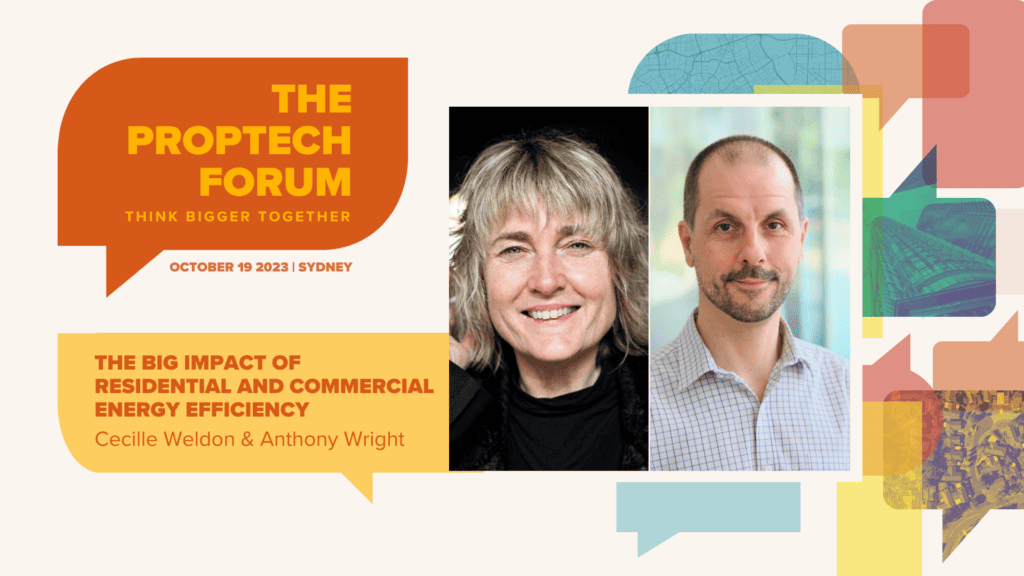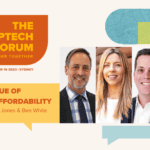New open source data from CSIRO is going to create a tsunami of opportunity for proptechs in residential and commercial energy efficiency, renovation and valuation spaces.
Cecille Weldon interviews the CSIRO’s Anthony Wright to give us the inside running.
Cecille Weldon
Anthony from the CSIRO, I'll let you introduce the session. OK. I'm aware I'm between you and a party pie so we'll be very quick because this is just a rapid fire set of questions for Anthony. We're not going to have time to answer all of them. So I'd encourage everyone to come to the roundtable think because he's going to be there and be able to unpack some of this exciting piece of information. I'm going to tell you, strangely, Anthony has a background in Criminology as well as Sarah Bell, so that sort of freaks me out a little. But he's also I was very grateful when I had to work directly with him in the CSIRO. Got a background in architecture and design is not just like a research boffin. So one of the things that I'm proud to have sort of brought into our conversations and last year we brought Melissa James here to talk about rapid rate, the AI machine learning rating system.
Cecille Weldon
Melissa works in Anthony's team. So just to give you some context there. So first of all Anthony, just quickly for context, what is CSIRO's interest in buildings? Like, where are they coming from?
Anthony Wright
Sure. So I sit in the energy Business unit, nothing to do with buildings, but we have an energy efficiency kind of program within the Energy Business unit and that is all about managing the decarbonization of the electricity grid. So we have two kind of aspects to that. One is managing energy efficiency, that's the behind the meter stuff in buildings. The other part is the grid transition poles and wires and so on. So within that I do the residential half and my colleague Stephen Wyatt essentially does the commercial buildings half.
Cecille Weldon
Anthony here is going to talk to us about some stuff around commercial data as well. So this isn't just about residential. So what do you think the big opportunities are for the people in the room in terms of the trajectory, in terms of the future? What do you think they should be really making sure they've got integrated into their solution in some way?

Anthony Wright
Well, the biggest thing is around transparency and disclosure at the moment I think. And that's not just residential.
Cecille Weldon
We're talking about energy ratings here, but sometimes disclosure is a word that the research community uses and all about it's about making that information transparent of point of sale or rent.
Anthony Wright
It's more than that too because I think it's around the banking and finance sector and the disclosure of financed emissions. So a lot of the decision making that's being driven at the moment is coming out of the legislative need to disclose financed emissions and that's across not just residential but small to medium enterprises, big business buildings. And I think the key missing part for me at the moment, I think residential will get there big commercial. We're probably a long way along that path already with things like neighbors and so on. But small to medium enterprises is a really big issue. How do banks and finance institutions understand small to medium enterprise emissions is a really big problem. There's people in the UK looking at that, but that's a really missing piece in Australia at the moment.
Cecille Weldon
What I hear there is agencies, anything in a franchise model is a shitload of small to medium businesses. And really understanding how to get to that opportunity around property is something interesting. As an opportunity in the residential space, what would you say are the big opportunities?
Anthony Wright
So I think the consumer conversation in the residential space is enormous. We have regulations for new buildings that you'd all be aware of and there is a Commonwealth process underway at the moment to expand that energy rating system for existing buildings as well. There is work being done on communicating energy ratings and carbon emissions to the banking and finance sector. There's less work going on in what happens at the consumer end. How do you aggregate retrofit services? How do you explain things to consumers? How do they understand the value of energy ratings and of energy efficiency and carbon? It comes down to resilience and risk as well. How do they understand resilience and risk issues in this space? So I think there's a lot of work to be done engaging consumers and also doing the follow up. So what happens after you've done the retrofit?

Anthony Wright
What was the impact of that? How do you report against that and who's collecting that data and passing it through to all of the people that need it?
Cecille Weldon
So I think what's interesting about this is really about the financial sector being driven by now having to report on their climate risk. And the climate risk is not just about the flyer and flood, but it's also about the failure of that property to upgrade in the right direction for comfort all year round, lower running costs. And this is that other side of affordability that we now I would love to see come together, but it's certainly going to become a much bigger discussion. So when it comes to if you've got that sort of side of things now coming in around that discussion, around affordability, that's also about new commercially exciting data sets that are coming in. The finance sector and valuation sector has, since we've met last year, been doing very robust pilots using rapid rate across their loan book, being able to instantly look at the climate risk.
Cecille Weldon
So that's a big shift where the big end of the town gets in the conversation. It's not just about that consumer protection side. So what is CSR going to do to unravel that treasure chest of data they've been collecting over all the years of compliance and all their touch points? Because it's notoriously locked. The legal team will send you crazy trying to interact with it as it did for me. So Anthony is going to just I think this is so exciting. So go on the big scoop.

Anthony Wright
So what we're hoping to do early next year is make available an API to collect NATA's rating data on all the houses that have been rated in Australia so far. So that's about 1.2 million properties at the moment and hopefully going to grow as we move into existing building ratings as well. So that should be available to anyone who wants a data license to access that API. And I'm hoping, fingers crossed, that will be free when it comes out next year. So with a bit of luck, everyone will get access to that. And that level of transparency in the commercial building sector, we're a little bit slower than that, but still working on some pretty big stuff. So my colleague Stephen White's working on something called the data clearinghouse. That is a platform which is capable of taking building data, so BMS data, IoT data, third party data and aggregating it with a uniform metadata schema.
Anthony Wright
And with the fair. I'm going to forget what that acronym is. Data principles findable accessible interoperable something else. Basically making aggregations of large commercial buildings think hospitals, schools, industrial facilities, commercial buildings and so on accessible to third parties so that they can develop applications so that they can meet the needs of those building owners and occupants and so on. That's already got 200 buildings last time I checked, give or take, and is growing really fast. So they've already aggregated about 1% of New South Wales's energy consumption. So that platform is growing really fast and is hopefully going to start providing a platform not only for app developers back to the building owners and occupants, but also ways of aggregating demand for the networks. Because one of the big problems we see is as we decarbonize our grid and we decarbonize our buildings, what's the relationship there?

Anthony Wright
Is it acceptable 20 years from now to be aiming for a net zero carbon rating essentially for an individual building? If we do that in residential, for example, does that mean we electrify all buildings and create a new winter peak demand when we have no solar or low solar production? What does it mean for over generating solar in summer? How are buildings and grids going to interact in a really dynamic way so that the grid is not just there to supply whatever the buildings need, but there is some backwards and forwards in communication between buildings and grids and that we can adjust loads in buildings to meet the needs of the grid and vice versa. So this data clearinghouse platform is designed to fill that space and give people access to that sort of data in order to aggregate loads and find ways of delivering services to the network as well as to the building owners.
Cecille Weldon
So one more question, which is when.
Anthony Wright
You can get involved in the Data clearinghouse?
Cecille Weldon
Now, there's not just the Data Clearing house the NATO's data and the NATO's.

Anthony Wright
Data will be first half next year. I can't promise you an actual date at this point in time. I have few last hurdles to overcome, but it's well on the way, so.
Cecille Weldon
I'm going to finish there just to wet your appetite. But we're going to be unpacking that a little bit more. If you've got any questions in the Energy Efficiency roundtable. And also talking about the impact on features and the big feature standard that we're working on, which is the world first as an industry prop tech industry. Okay, thanks everyone.
Anthony Wright
Thank you very much. Thank you, Anthony.



